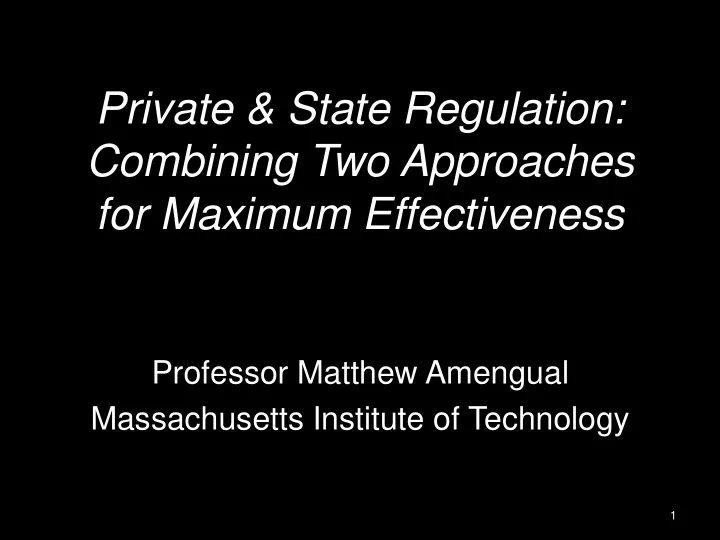

Private & State Regulation: Combining Two Approaches for Maximum Effectiveness Professor Matthew Amengual Massachusetts Institute of Technology 1
Overview • How can do private and state regulation relate to one another? • Fundamentals of co-production • Fundamentals of reinforcement • Policy lessons and implications 2
A Division of Labor - Towards Coproduction Institutional plurality raises the possibility of complements Private already supports the state, and visa- versa
Monitoring and Issue Focus Private State Police patrol: Private Fire alarm: State regulation conducts regulators rely on preventative, timed, complaints of workers, audits of factories, as unions, and NGOs. well as follow-up audits.
Sanctions & Rewards Private State Commercial incentives of Fines and court settlements. factories losing business. Rarely applied, but highly Rarely applied, but highly costly costly
Pedagogy Private State Teach factories how to Teach managers about the manage production content of the law and obligations. Teach managers about international standards of Teach workers about their worker-management dialogue rights.
Conciliation & Adjudication Private State Preventative training. Inspectors conciliate conflicts between workers and Difficult to conciliate conflict management. between workers and management when it hits a If solutions cannot be found high level. or a legal question needs to be resolved, inspectors adjudicate these conflicts
Examples: Different problems, same factory in the Dominican Republic • Private : Health and safety, contracts, overtime • State : Freedom of association conflicts
Drivers of Complementary Regulation 1. Non-substitutable inputs into regulation by private and state actors – different capabilities and objectives 2. Reducing pressure on the resources of state regulator to attend to industries outside removed from global regulatory networks
Beyond coproduction: Thinking about how private can reinforce state institutions Factory responses to formal rules: REINFORCEMENT 1. Engage in state institutions and follow the rules of the game 1. Defect from state institutions, ignore formal rules and 10
Garment Factory Responses to Minimum Wage Increases in Indonesia 1. Pay higher minimum wage REINFORCEMENT 2. Go through legal process of “postponement” 1. Informal negotiation to gain illegal approvals from workers & local regulators for lower wages. would be approved by supervised formal process 2. Imposition of lower wages without any negotiation 11
BWI Response to Minimum Wage: Pushing Factories to Engage with the State 1. Incentives : BWI marked factories as non- compliant when they did not pay or legally renegotiated. Resulted in strong pressure from buyers sensitive to wage violations 2. Information : BWI issued four “Legal Updates” informing all factories & buyers about requirements, based on MOMT interpretation 12
BWI’s Response: Factory in Jakarta 1. Minimum wage increased to US $197/month in 2012 2. Managers “ explained ” to workers that “ we cannot survive because there are many expenses ,” and union was “ silent .” Management offered $185 and the union agreed. 3. BWI said this was invalid, factory had to go through formal process of renegotiation. Management asked: “ Do we have another way ?” The answer was no . 4. BWI coached factory through supervised renegotiation process, the $185 wage was rejected by governor. 5. After supervised renegotiation, the factory paid $189. 13
Quantitative Analysis • Were BWI factories morel likely to file for postponement compared with: – Non-BWI factories – BWI factories in districts without mobilization • Data: Directory of Manufacturing, participation in supervised wage renegotiations • Subsetted regression analysis, DV=renegotiation, key IV is participation in BWI 14
Summary Statistics Data from BPS Industrial Manufacturing Directory 15
Regression Analysis (separated by districts) 16
Regulatory Structure Information BWI Buyers Information Incentives Factories
Regulatory Structure Information Local governments BWI (DINAS) Buyers Inst. Information processes Pressure Incentives Factories District / factory Pressure unions 18
Regulatory Structure Ad Hoc committee & Federal Informal government consultations (MOMT) Information Local governments BWI (DINAS) Buyers Inst. Information processes Pressure Incentives Factories District / factory Pressure unions 19
Policy Implications • Design private regulatory initiatives to meet the specific weaknesses of labor inspection • Do not expect that private regulatory initiatives can substitute for the state, as they have their own weakness • Private initiatives are most likely to strengthen state ones when there is social mobilization activating state institutions, and when there is authoritative guidance on legal questions 20
Recommend
More recommend